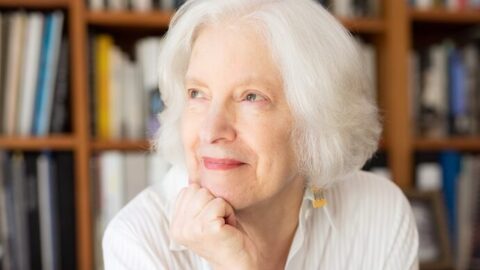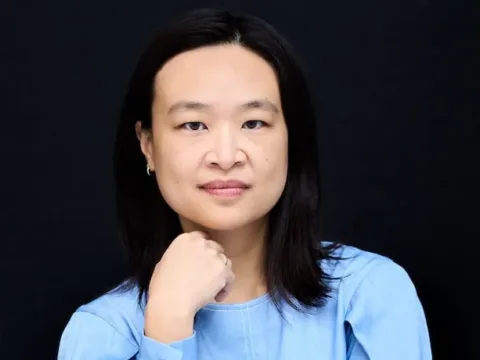Renowned composer Judith Shatin has been coaxing new sounds from familiar and unexpected places since college. She had an acoustic upbringing (as a pianist and flutist), a tiptop compositional education (Juilliard, Princeton), and spent time in the 70s tinkering with tape recorders, a Buchla synthesizer, and mainframe computers. While Shatin’s early explorations with electronics left her unsatisfied, she continued to focus on her acoustic composition, biding her time until music technology developed a bit further. In 1987 — after the introduction of MIDI — Shatin founded the Virginia Center for Computer Music (VCCM) to create more digital music opportunities for students and faculty. She taught at the University of Virginia for 39 years and is currently William R. Kenan Jr. Professor Emerita.
Shatin goes through life with her “sonic antennae up” and collaborates closely with her performers to explore new timbres for her pieces. Critics praise her vivid, inventive sounds, dynamic narrative design, and ability to grab listeners’ attention. We caught up with Shatin during this snapshot in time to learn more about her process and upcoming performances.
You’re very involved with your performers, often working with them to devise concepts and craft unique sounds. How has this collaborative process helped to shape some of the music that will be featured in your upcoming performances?
Collaboration is central to my being. First, I love it! I delight in the play of sonic exploration and the joy of these interactions with performers. Second, I am ever more intrigued by the meaning and feeling of timbre. I am so grateful to the many performers with whom I have experimented. And, while I continue to compose with traditional techniques, the expansion of timbral range affords even greater expressivity. We modulate our own voices with a tremendous acuity, from delicate whispers to screams of rage. The same is true for music.
Two pieces with upcoming performances have benefited from such collaboration: Adventure on Mt. Hehuan and Of Wells and Springs. I composed the former for percussionist I-Jen Fang, with whom I’ve been exploring percussion. Mt. Hehuan is the name of a mountain in Taiwan and translates as “Mountain of Joy.” I spent weeks exploring the bass drum: mallets, points of contact with the drum, the multitude of ways of using the mallets, including rim glissandi. The resultant piece, for solo bass drum and optional interactive electronics, embodies the idea of adventure — its leaps, bounds, resting points, exhilaration. I-Jen and I will perform it on April 7 at the DiMenna Center, in New York.
Of Wells and Springs is the result of a consortium commission spearheaded by the Bent Frequency Duo Project (Jan Berry Baker and Stuart Gerber) for alto sax and percussion. I had an extensive session with Jan before starting. This gave me a richer sense of her particular sound and led to several discoveries. I also discussed the piece with the performers to get a sense of what was important to them. Jan came up with an answer: water — in all of its meanings. I took inspiration, and the piece’s title, from Wendell Berry’s poem Water. It speaks of drought in a vivid way, and of the rain that finally comes. Given the fraught situation we are all in — with droughts and floods intensifying, this topic felt all too timely. The duo will premiere Of Wells and Springs on May 5 in Atlanta.
Werther is set to receive its European premiere on March 8, but it originally premiered 40 years ago. How has your relationship with the piece evolved over the years?
As I look back on Werther, I realize that even then I wanted to find ways to rebalance the notion of ‘sounding idea,’ in a way that took ‘sounding’ into much greater account. Further, I wanted to find new ways to think about narrative that went beyond what is typically, often pejoratively, called ‘program music.’ In the case of Werther, composed for and recorded by Da Capo Chamber Players, what I took from Goethe’s novel was the expressive element. It is a piece about emotional anguish that cannot find resolution. Werther begins with what my pianist muse Gayle Martin has called “a cry into the void.” I marked the opening ‘Piercing.’ There is a melding of structure and timbral expressiveness, here using mainly traditional instrumental techniques to create a narrative from the combination of instrumental interaction, dynamics and pacing. One does not need to know the backstory to experience the structure and feeling of the music. I think of this piece as one of the many in the evolution of my practice and I’m delighted that the Hard Rain Ensemble is giving the European premiere in Belfast.

You’ve spoken about the “particularity of sound in register” (e.g., a high G on the flute doesn’t sound the same as the G an octave lower). How do you approach arranging your pieces for new instrument configurations, like your choral piece La Frontera — originally written for SATB choir — which will receive its TTBB premiere by the Washington Men’s Camerata on March 25?
As a young composer at a time and place when serial techniques were very much in vogue, I was bothered by the lack of attention to timbre, precisely because even in the case of registral shifts, timbre, and our experience of it, changes dramatically. My interest in rescoring some of my pieces for other instruments came after the premiere of Grito del Corazón, commissioned by the Barcelona New Music Ensemble, a group of improvisers. The original was created for a program called Painting Music and was inspired by Goya’s Black Paintings. I scored it for guided improvisation, with motivic elements for each instrument, and electronics. There is also a video by the innovative artist Kathy Aoki. Numerous ensembles and soloists wanted to perform it, and I thought that the more open form lent itself to reinterpretation. There is an upcoming performance (a first by flute quartet) on a program of my music at the National Flute Association Convention in Phoenix on August 6!
I have by now made multiple versions of a number of acoustic and electroacoustic pieces, typically for one or two instruments, as well as multiple choral versions, as in the case of La Frontera (The Border). Here, I set a poem by an undocumented youth trying to immigrate to the U.S. and winding up in maximum security detention. The original version was for SATB choir and piano. My goal was to bring attention to the issue of immigration and especially its impact on many youths. I am donating 100 percent of score sales to the excellent CAIR Coalition’s Detained Children’s Program to try to translate this piece into action beyond performance. The versions for TTBB, for SSA, and for solo singers (with piano in each case), involved revising the tessitura as well as some melodic elements for each combination. The projection of the words was key in each.
You are a thoughtful integrator of digital technologies. How have the increasingly rapid changes in technology affected the way you approach your work?
When I founded the Virginia Center for Computer Music at the University of Virginia, MIDI had just been invented and PCs were new. Mainframe computers were used for music composition in a few places, one being at Princeton University, where, as a graduate student, I had my first experiences composing computer-generated sound. We opened the VCCM with a Mac II, a couple of Mac SEs, an Amiga and a bunch of outboard equipment. My first piece was Hearing Things, for amplified violin, MIDI keyboard controller, Mac II running an early language called HMSL, an effects processor, sampler and voice processor! The biggest changes included managing ever-changing programming environments, moving from outboard peripherals to plugins and the quicksilver obsolescence of equipment. It is a given that technology changes, and while it often feels disruptive, there are aspects that enable terrific opportunities, and I am not done exploring them.
Which rhythms, timbres, patterns, wild animal sounds, or other things have been tickling your sonic antennae lately?
There are many, from the sounds of glaciers to the pull of zippers! Ice Becomes Water, scored for string orchestra and electronics fashioned from field recordings shared by glaciologist Oscar Glowacki was commissioned by the San Jose Chamber Orchestra. I chose this topic as glaciers are in dramatic retreat, with devastating implications. I fashioned the electronics by processing these recordings. Some remain recognizable, while others, such as the high, thin sound of the opening, are transformed beyond recognition.
Another piece, Terra Infirma, resulted from research I embarked on when commissioned by Michigan Technological University to create a piece as part of a residency. I decided to create a piece about the Great Lakes, initially titled Watershed. However, as I delved into the topic, what struck me was the perilous condition of many animals and the pollution and effects of climate change on the lakes. This led me to compose Terra Infirma, for amplified septet and electronics fashioned from the voices of the animals as well as the sounds of the lakes. It was quite a journey, with numerous collaborators who are credited on the score. Here, I will just mention the calls of whooping cranes shared by Dr. Bernhard Wessling. His and many others’ conservation efforts have rescued them from the brink of extinction. Terra Infirma was premiered at Michigan Technological University, conducted by Joel Neves, followed by a performance by the Chicago-based Fulcrum Point Project, led by Stephen Burns.
The sounds of the world never fail to inspire. Another example is Zipper Music, scored for 2 – 4 amplified zipper players and interactive electronics. This began when I was messing with the zipper on a jacket and becoming intrigued by the resultant timbres and how they varied, depending on speed, rhythm, and whether I created a resonant chamber by pulling some of the material away from my body. The sonic world is a treasure trove, and I am grateful to have access!
I CARE IF YOU LISTEN is an editorially-independent program of the American Composers Forum, and is made possible thanks to generous donor and institutional support. Opinions expressed are solely those of the author and may not represent the views of ICIYL or ACF.
You can support the work of ICIYL with a tax-deductible gift to ACF. For more on ACF, visit the “At ACF” section or composersforum.org.
























